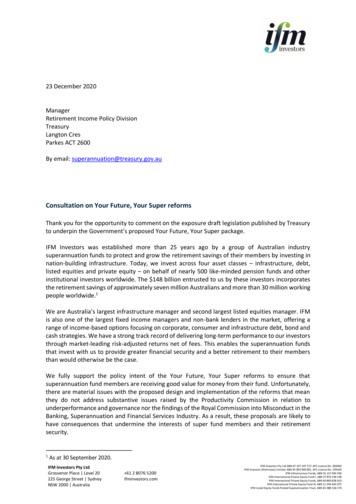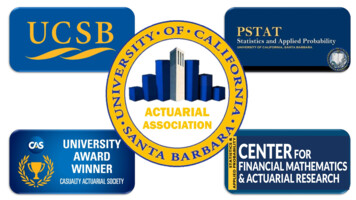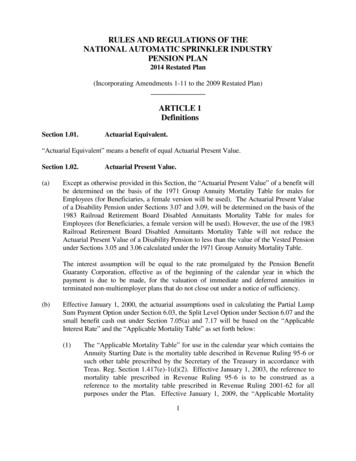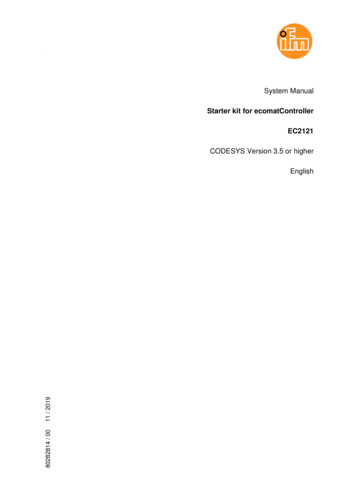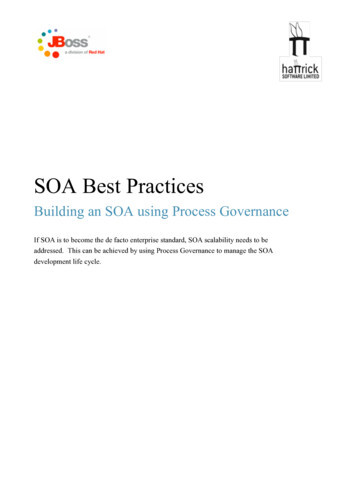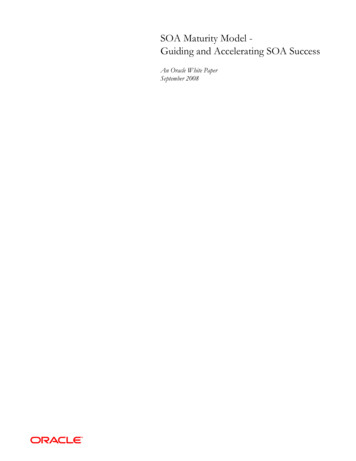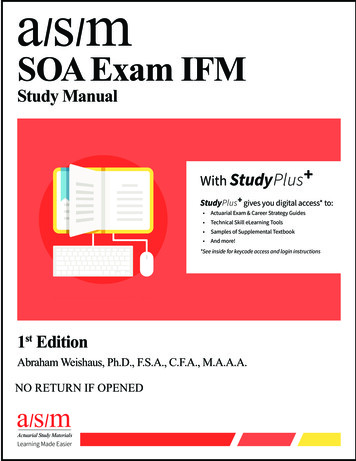
Transcription
SOA Exam IFMStudy ManualWith StudyPlus StudyPlus gives you digital access* to: Actuarial Exam & Career Strategy Guides Technical Skill eLearning Tools Samples of Supplemental Textbook And more!*See inside for keycode access and login instructions1st EditionAbraham Weishaus, Ph.D., F.S.A., C.F.A., M.A.A.A.NO RETURN IF OPENEDActuarial Study MaterialsLearning Made Easier
Contents1Introduction to DerivativesExercises . . . . . . . . . . . . . . . . . . . . . . . . . . . . . . . . . . . . . . . . . . . . . . .Solutions . . . . . . . . . . . . . . . . . . . . . . . . . . . . . . . . . . . . . . . . . . . . . . .2Project Analysis2.1 NPV . . . . . . . . . . . . . . . .2.2 Project analysis . . . . . . . . .2.2.1 Break-even analysis . . .2.2.2 Sensitivity analysis . . .2.2.3 Scenario analysis . . . .2.3 Risk measures . . . . . . . . . .2.3.1 Four risk measures . . .2.3.2 Coherent risk measuresExercises . . . . . . . . . . . . .Solutions . . . . . . . . . . . . .556677881011143Monte Carlo SimulationExercises . . . . . . . . . . . . . . . . . . . . . . . . . . . . . . . . . . . . . . . . . . . . . . .Solutions . . . . . . . . . . . . . . . . . . . . . . . . . . . . . . . . . . . . . . . . . . . . . . .1923394Efficient Markets Hypothesis (EMH)Exercises . . . . . . . . . . . . . . . . . . . . . . . . . . . . . . . . . . . . . . . . . . . . . . .Solutions . . . . . . . . . . . . . . . . . . . . . . . . . . . . . . . . . . . . . . . . . . . . . . .5356575Mean-Variance Portfolio TheoryExercises . . . . . . . . . . . . . . . . . . . . . . . . . . . . . . . . . . . . . . . . . . . . . . .Solutions . . . . . . . . . . . . . . . . . . . . . . . . . . . . . . . . . . . . . . . . . . . . . . .5968726Capital Asset Pricing Model (CAPM)6.1 Required return . . . . . . . . . .6.2 CAPM . . . . . . . . . . . . . . .Exercises . . . . . . . . . . . . . .Solutions . . . . . . . . . . . . . .77777881857Cost of Capital7.1 Estimating CAPM’s parameters7.2 Project cost of capital . . . . . .Exercises . . . . . . . . . . . . .Solutions . . . . . . . . . . . . .89899092988Behavioral Finance and Multifactor Models8.1 Behavioral finance . . . . . . . . . . . . .8.2 Multifactor models . . . . . . . . . . . .Exercises . . . . . . . . . . . . . . . . . .Solutions . . . . . . . . . . . . . . . . . .1031031041061079Capital StructureExercises . . . . . . . . . . . . . . . . . . . . . . . . . . . . . . . . . . . . . . . . . . . . . . .109112IFM Study Manual—1st editionCopyright 2018 ASM.iii.134
ivCONTENTSSolutions . . . . . . . . . . . . . . . . . . . . . . . . . . . . . . . . . . . . . . . . . . . . . . .11510 The Effect of Taxes on Capital StructureExercises . . . . . . . . . . . . . . . . . . . . . . . . . . . . . . . . . . . . . . . . . . . . . . .Solutions . . . . . . . . . . . . . . . . . . . . . . . . . . . . . . . . . . . . . . . . . . . . . . .11912112311 Other Factors Affecting Optimal Debt-Equity Ratio11.1 Bankruptcy and Financial Distress . . . . . . . .11.2 Agency costs and benefits . . . . . . . . . . . . .11.3 Asymmetric information . . . . . . . . . . . . . .Exercises . . . . . . . . . . . . . . . . . . . . . . .Solutions . . . . . . . . . . . . . . . . . . . . . . .12712712913013113512 Equity Financing12.1 Sources of capital for private companies . . . .12.2 Allocation of company value among investors .12.3 Going public: the IPO . . . . . . . . . . . . . .12.4 IPO puzzles . . . . . . . . . . . . . . . . . . . .Exercises . . . . . . . . . . . . . . . . . . . . . .Solutions . . . . . . . . . . . . . . . . . . . . . .13913913914114214314513 Debt Financing13.1 Corporate Debt13.2 Other Debt . . .Exercises . . . .Solutions . . . .14714714814915014 Forwards14.1 How a forward works . . . . . . . . . . . . . . . . . . . . . . .14.2 Pricing a Forward . . . . . . . . . . . . . . . . . . . . . . . . . .14.3 Additional Comments on Forwards . . . . . . . . . . . . . . .14.3.1 Forward Premium . . . . . . . . . . . . . . . . . . . . .14.3.2 Comparison of Forward Price to Expected Future Price14.4 Synthetic forwards . . . . . . . . . . . . . . . . . . . . . . . . .Exercises . . . . . . . . . . . . . . . . . . . . . . . . . . . . . . .Solutions . . . . . . . . . . . . . . . . . . . . . . . . . . . . . . .15115115215515515615615716115 Variations on the Forward Concept15.1 Prepaid forwards . . . . . . . .15.2 Futures . . . . . . . . . . . . . .Exercises . . . . . . . . . . . . .Solutions . . . . . . . . . . . . .16516516616717016 Options16.1 Call options16.2 Put options .Exercises . .Solutions . .17317317517618117 Option Strategies17.1 Options with Underlying Assets . . . . . . . . . . . . . . . . . . . . . . . . . . . . . . . . .17.2 Synthetic Forwards . . . . . . . . . . . . . . . . . . . . . . . . . . . . . . . . . . . . . . . . .185185187IFM Study Manual—1st editionCopyright 2018 ASM.
vCONTENTS17.3 Bear Spreads, Bull Spreads, and Collars . . . . . . . . . . . . . . . . . . . . . . .17.3.1 Spreads: buying an option and selling another option of the same kind .17.3.2 Collars: buying one option and selling an option of the other kind . . .17.4 Straddles, Strangles, and Butterfly Spreads . . . . . . . . . . . . . . . . . . . . .Exercises . . . . . . . . . . . . . . . . . . . . . . . . . . . . . . . . . . . . . . . . .Solutions . . . . . . . . . . . . . . . . . . . . . . . . . . . . . . . . . . . . . . . . .18 Put-Call Parity18.1 Stock put-call parity . . . . . . .18.2 Synthetic stocks and Treasuries18.3 Synthetic options . . . . . . . .18.4 Currency options . . . . . . . .Exercises . . . . . . . . . . . . .Solutions . . . . . . . . . . . . .188188192193196206.21121221321421521722419 Comparing Options19.1 Bounds for Option Prices . . . . . .19.2 Early exercise of American options19.3 Time to expiry . . . . . . . . . . . .19.4 Different strike prices . . . . . . . .19.4.1 Three inequalities . . . . . .19.4.2 Options in the money . . .Exercises . . . . . . . . . . . . . . .Solutions . . . . . . . . . . . . . . .23323323523824224225025125320 Binomial Trees—Stock, One Period20.1 Risk-neutral pricing . . . . . . .20.2 Replicating portfolio . . . . . .20.3 Volatility . . . . . . . . . . . . .Exercises . . . . . . . . . . . . .Solutions . . . . . . . . . . . . .25925926126526827621 Binomial Trees—General21.1 Multi-period binomial trees21.2 American options . . . . . .21.3 Currency options . . . . . .21.4 Futures . . . . . . . . . . . .21.5 Other assets . . . . . . . . .Exercises . . . . . . . . . . .Solutions . . . . . . . . . . .28728728828929129429530422 Binomial Trees: Understanding Early Exercise of OptionsExercises . . . . . . . . . . . . . . . . . . . . . . . . . . . . . . . . . . . . . . . . . . . . . . .Solutions . . . . . . . . . . . . . . . . . . . . . . . . . . . . . . . . . . . . . . . . . . . . . . .31932032123 Modeling Stock Prices with the Lognormal Distribution23.1 The normal and lognormal distributions . . . . . . . .23.1.1 The normal distribution . . . . . . . . . . . . .23.1.2 The lognormal distribution . . . . . . . . . . .23.1.3 Jensen’s inequality . . . . . . . . . . . . . . . .23.2 The lognormal distribution as a model for stock prices23.2.1 Stocks without dividends . . . . . . . . . . . .323323323324325326326IFM Study Manual—1st editionCopyright 2018 ASM.
viCONTENTS23.2.2 Stocks with dividends . . . . . . . . . . .23.2.3 Prediction intervals . . . . . . . . . . . . .23.3 Conditional payoffs using the lognormal modelExercises . . . . . . . . . . . . . . . . . . . . . . .Solutions . . . . . . . . . . . . . . . . . . . . . . .32832933033633824 The Black-Scholes Formula24.1 Black-Scholes Formula for common stock options .24.2 Black-Scholes formula for currency options . . . .24.3 Black-Scholes formula for options on futures . . .Exercises . . . . . . . . . . . . . . . . . . . . . . . .Solutions . . . . . . . . . . . . . . . . . . . . . . . .34534634935035135725 The Black-Scholes Formula: Greeks25.1 Greeks . . . . . . . . . . . . . . . . .25.1.1 Delta . . . . . . . . . . . . . .25.1.2 Gamma . . . . . . . . . . . .25.1.3 Vega . . . . . . . . . . . . . .25.1.4 Theta . . . . . . . . . . . . . .25.1.5 Rho . . . . . . . . . . . . . . .25.1.6 Psi . . . . . . . . . . . . . . .25.1.7 Greek measures for portfolios25.2 Elasticity and related concepts . . . .25.2.1 Elasticity . . . . . . . . . . . .25.2.2 Related concepts . . . . . . .25.2.3 Elasticity of a portfolio . . . .25.3 What will I be tested on? . . . . . . .Exercises . . . . . . . . . . . . . . . .Solutions . . . . . . . . . . . . . . . 6 Delta Hedging26.1 Overnight profit on a delta-hedged portfolio26.2 The delta-gamma-theta approximation . . . .26.3 Hedging multiple Greeks . . . . . . . . . . .26.4 What will I be tested on? . . . . . . . . . . . .Exercises . . . . . . . . . . . . . . . . . . . . .Solutions . . . . . . . . . . . . . . . . . . . . .40740741141341541642427 Asian, Barrier, and Compound Options27.1 Asian options . . . . . . . . . . . .27.2 Barrier options . . . . . . . . . . . .27.3 Maxima and minima . . . . . . . .27.4 Compound options . . . . . . . . .27.4.1 Compound option parity .Exercises . . . . . . . . . . . . . . .Solutions . . . . . . . . . . . . . . .43343343744044244344445128 Gap, Exchange, and Other Options28.1 Gap options . . . . . . . . . . . . . . . . . . . .28.1.1 Definition of gap options . . . . . . . .28.1.2 Pricing gap options using Black-Scholes28.1.3 Delta hedging gap options . . . . . . . .459459459461463IFM Study Manual—1st editionCopyright 2018 ASM.
viiCONTENTS28.2 Exchange options . . . . . . .28.3 Other exotic options . . . . . .28.3.1 Chooser options . . . .28.3.2 Forward start optionsExercises . . . . . . . . . . . .Solutions . . . . . . . . . . . .46446646646746947829 Supplementary Questions—DerivativesSolutions . . . . . . . . . . . . . . . . . . . . . . . . . . . . . . . . . . . . . . . . . . . . . . .48749530 Real Options30.1 Decision trees . . . . . . .30.2 Black-Scholes . . . . . . .30.3 Option to abandon projectExercises . . . . . . . . . .Solutions . . . . . . . . . .50550550750850951131 Actuarial Applications of Options31.1 Variable annuities . . . . . . . . . . . . . . . . . .31.2 Mortgage guaranty insurance . . . . . . . . . . .31.3 Other insurance features that constitute options31.4 Static hedging strategies using exotic options . .31.5 Dynamic hedging . . . . . . . . . . . . . . . . . .31.6 Hedging catastrophe risk . . . . . . . . . . . . . .Exercises . . . . . . . . . . . . . . . . . . . . . . .Solutions . . . . . . . . . . . . . . . . . . . . . . .515515517517518519519520522Practice Exams.5251Practice Exam 15272Practice Exam 25373Practice Exam 35474Practice Exam 45575Practice Exam 55676Practice Exam 65757Practice Exam 75838Practice Exam 85919Practice Exam 959910 Practice Exam 1060711 Practice Exam 11617IFM Study Manual—1st editionCopyright 2018 ASM
viiiCONTENTSAppendicesA Solutions to Old ExamsA.1 Solutions to SOA Exam MFE, Spring 2007 . . . . . . .A.2 Solutions to CAS Exam 3, Spring 2007 . . . . . . . . .A.3 Solutions to CAS Exam 3, Fall 2007 . . . . . . . . . . .A.4 Solutions to Exam MFE/3F, Spring 2009 . . . . . . . .A.5 Solutions to Advanced Derivatives Sample Questions627.629629633636640643B Lessons Corresponding to Questions on Released and Practice Exams655C Standard Normal Distribution Function Table659IFM Study Manual—1st editionCopyright 2018 ASM
Lesson 2Project AnalysisReading: Corporate Finance 8.5, IFM 21-18 2–3This lesson begins the corporate finance part of the course. From here up to and including Lesson 13,when not told otherwise, assume that interest rates are annual effective.2.1NPVWhen a company considers embarking on a project, it must verify that this project will meet the company’sfinancial goals. The measure we will use for this is NPV, or net present value. To compute the NPV wecalculate the free cash flows of the project. The free cash flows are the cash amounts generated by theproject itself, both positive and negative, year by year. Cash flows do not include non-cash accountingitems, such as depreciation.1 The free cash flows also do not include cash flows from financing used tosupport the project. If a loan is taken to pay the project’s initial expenses, neither the loan nor interest onthe loan is part of free cash flows. Free cash flows are purely cash generated by the project itself.The NPV is the present value, at the start of the project, of the project’s free cash flows. At whatinterest rate is the NPV calculated? Usually the NPV is calculated at the interest rate the company mustpay to finance the project. In other words, the NPV is calculated at the interest rate that has to be paid toinvestors in order to get them to invest in the project. This interest rate is called the cost of capital. We willdiscuss what the cost of capital should be in the following lessons.Example 2A A life insurance company is considering developing a new Universal Life product. It willcost 5 million, payable immediately, to develop this product, and developing the product will take ayear. The company estimates free cash flows will be 1 million at the end of the first year, followed by 1 million per year for 5 years, and will then decrease at a compounded rate of 10% per year after that.The company’s cost of capital is 12%.Calculate the NPV of the project.Answer: The NPV generated during the first 6 years is a1 1/1.1251,000,000 5,0000,000 1,000,000 5 0.12 5,797,194 1,000,000 2,674,3071.121.120.12(1.12)After 6 years, free cash flows form a geometric series with first term 900,000/1.127 and ratio 0.9/1.12. TheNPV generated after year 6, in millions, is9000,000 1/1.127 2,072,5821 0.9/1.12Total NPV is 2,674,307 2,027,582 601,725 . Companies should invest in a project only if NPV 0. Otherwise they destroy the value of thecompany.1However, for insurance products, they include changes in reserves. A company must set aside cash to support the reserves,although this cash may be invested.IFM Study Manual—1st editionCopyright 2018 ASM5
62. PROJECT ANALYSISIf we assume that free cash flows are constant, they form a perpetuity. As you learned in FinancialMathematics, the present value at of an immediate perpetuity of 1 per year is 1/i, where i is the interestrate. If the free cash flows are 1 in the first year and grow at compounded rate g, then their present valueisNPV Õ(1 g)n 1n 1(1 i)n1/(1 i)1 (1 g)/(1 i)1/(1 i)1 (i g)/(1 i) i g ?(2.1)Quiz 2-1 A company is considering a project. This project will require an investment of 10 millionimmediately and will generate free cash flows of 1 million per year at the end of one year, increasing at acompounded rate of 3% per year perpetually.The cost of capital is 9%.Calculate the NPV of the project.2.22.2.1Project analysisBreak-even analysisCompanies analyze the risk in a project. One way to analyze the risk is to vary the assumptions used tocalculate the NPV with the changed assumptions. Break-even analysis consists of determining the value ofeach assumption parameter for which the NPV is 0, assuming that the other assumption parameters areat their baseline values.Calculation of IRR is an example of break-even analysis. IRR, the internal rate of return, is an alternativeprofit measure to NPV. The IRR is the interest rate r such that the present value of free cash flows at r is 0.Assuming the usual pattern of negative free cash flows initially followed by positive free cash flows, IRRis the highest interest rate for which the NPV is at least 0. Thus IRR is the highest interest rate for whichthe company breaks even.A similar analysis can be done for the other parameters. A break-even analysis calculates the breakeven level of number of sales, expenses, sales price, level of cash flows per year, and any other parameter.Example 2B A project requires an immediate investment of 19 million. It is expected to generate free cashflows of 2 million per year at the end of the first year, growing 2% per year perpetually. The cost of capitalis 12%.Perform a break-even analysis on the rate of growth of free cash flows.Answer: Let g be the growth rate. We want to solve 15 20.12 g2 00.12 g2 190.12 g20.12 g 19g 0.01474 0 19 IFM Study Manual—1st editionCopyright 2018 ASM
72.2. PROJECT ANALYSIS?Quiz 2-2 A project to develop a new product requires an immediate investment of 9 million. It will thengenerate free cash flows of 1 million per year starting with the end of the first year, until the productbecomes obsolete and cannot be sold. The cost of capital is 10%.Perform a break-even analysis on the number of years the product must sell.2.2.2Sensitivity analysisSensitivity analysis consists of calculating the change in the NPV resulting from a change in a parameter.Typically one sets the parameter to its value in the worst possible case and the best possible case, andcalculates the NPV for both cases. This analysis shows which parameters have the greatest impact on theNPV.Example 2C A project to develop a new product requires an immediate investment of 15 million. Freecash flows generated by this project are 20% of sales. Sales are expected to be level, and to continue for acertain number of years, at which point the product becomes obsolete. The best and worst cases for eachassumption are:Worst caseBaselineBest case430.16550.12670.08Annual sales ( million)Number of yearsCost of capitalPerform a sensitivity analysis on the three factors listed in the table. Which factor is the NPV mostsensitive to?Answer: We’ll do all calculations in millions.For annual sales s:NPV 15 sa 5 0.12 1 1/1.125 15 s0.12which is 0.581 million for s 4 and 6.629 million for s 6, a variation of 7.210 millionFor number of years n:NPV 15 5a n 0.121 1/1.12n 15 50.12which is 2.991 million for n 3 and 7.818 million for n 7, a variation of 10.809 million.For cost of capital r: 1 1/(1 r)5NPV 15 5a5 r 15 5rwhich is 1.371 million for r 0.16 and 4.964 for r 0.08, a variation of 3.593 million.We see that number of years of sales is the assumption to which NPV is most sensitive.2.2.3 Scenario analysisOften parameters are correlated and should not be analyzed separately. For example, increasing the priceof a product may lower sales. Scenario analysis consists of calculating the NPV for various scenarios.A scenario may vary two parameters in a consistent manner, leaving the other parameters unchanged ifthey are uncorrelated.IFM Study Manual—1st editionCopyright 2018 ASM
82. PROJECT ANALYSIS2.3Risk measuresIn the previous section we analyzed risk by varying parameters. An alternative method for analyzingrisk is to assign a number to the project indicating its riskiness. This section discusses such risk measures.Each of these risk measures is a function from a random variable to a real number. The random variablemay be profits, returns on investment, or aggregate loss amounts paid by an insurance company. Noticethat the direction of risk for aggregate loss amounts is the opposite of profits or returns: the risk is thatprofits or returns are low and that loss amounts are high.2.3.1Four risk measuresWe will discuss four risk measures: variance, semi-variance, VaR, and TVaR.VarianceVariance is a popular risk measure and will be used in mean-variance portfolio theory, which we discussstarting in Lesson 5. If R is the random variable for the return on an investment, the mean return is µ andthe variance isVar(R) σ 2 E[(R µ)2 ] E[R 2 ] µ2(2.2)An equivalent risk measure is the square root of the variance, or the standard deviation σ. We’ll also usethe notation SD(R) for the standard deviation.SD(R) pVar(R) σThe standard deviation of the rate of return is also called the volatility of the rate of return.The variance may be estimated from a sample using the formulaσ̂2 nÕ(R i R̄)2i 1nwhere R̄ is the sample mean. That is the formula given in the study note, but usually the denominator isn 1 instead of n to make this estimate unbiased. In fact, the formula for estimating volatility given inthe Berk/DeMarzo textbook is equation (5.1) on page 59, and that formula divides by n 1.Semi-varianceSince we are more concerned with underperformance than overperformance, at least for profits and ratesof return on investments, we may prefer the downside semi-variance, which we’ll refer to as the semivariance for short, as a measure of risk. The semi-variance considers the square difference from the meanonly when that difference is negative. It is defined by 2σSV E min 0, (R µ) 2 (2.3)The semi-variance is positive even though it is based on negative differences from the mean, sincethe differences are squared. The square root of the downside semi-variance is the downside standarddeviation.Example 2D The random variable X has an exponential distribution with mean 1:f X (x) e x ,Calculate the semi-variance of X.IFM Study Manual—1st editionCopyright 2018 ASMx 0
92.3. RISK MEASURESAnswer: We integrate min(0, x 1)2 over the density function. This minimum is 0 for x 1, so we onlyintegrate up to 1. We’ll integrate by parts twice. 012 x(x 1) e 2 xdx (x 1) e 1 2 (x 1)e x10 01 201e x dx1 0(x 1)e x dx 1 2 2(1 e 1 ) 1 2e 1 0.264241 The sum of the downside semi-variance and the upside semi-variance is the variance: E[(X µ)2 ] E min(0, X µ) max(0, X µ) 2 E[min(0, X µ)2 ] E[max(0, X µ)2 ] 2 E[min(0, X µ) max(0, X µ)]The first term of the last expression is the downside semi-variance. The second term is the upside semivariance. The third term is 0, since 0 is either the minimum or the maximum, so one factor is always 0.However, the semi-variance doesn’t have many of the nice properties of variance. For example, there isno easy formula for the semi-variance of a sum of two random variables.The semi-variance may be estimated from a sample by2σ̂SV ?n 21Õmin 0, (R i R̄)n(2.4)i 1Quiz 2-3 You are given the following sample:510152025Calculate the sample semi-variance.Value-at-Risk (VaR)The VaR of a random variable X at level α is the 100α percentile of the random variable. For a continuousrandom variable, it is x such that Pr(X x) α. For profits or rates of return, where the risk is that Xis low, α is picked low, with values like 0.05, 0.025, 0.01, 0.005. For aggregate insurance losses, where therisk is that X is high, α is picked high, with values like 0.95, 0.975, 0.99, 0.995.The VaR is calculated by inverting the cumulative distribution function: 1VaRα (X) FX(α)Example 2E Profits have a distribution with the following density function:f (x) Calculate VaR of profits at the 0.01 level.IFM Study Manual—1st editionCopyright 2018 ASM3(1 x)4x 0(2.5)
102. PROJECT ANALYSISAnswer: Integrate f (x) to obtain the cumulative distribution function, then invert that function at 0.01.F(x) x011 0.01(1 x)31 x p33 dt1 1 4(1 t)(1 x)31/0.99 1.003356x 0.003356 To estimate VaR from a sample, the sample is ordered from lowest to highest, and then the 100αpercentile is selected. This percentile is not well-defined since a sample is a discrete distribution, so somerule for selecting the percentile is needed. For example, if the sample is size 1000 and α 0.05, then onemight set the sample VaR equal to the 50th order statistic (most conservative), the 51st order statistic, orsome weighted average of the two, such as the smoothed empirical percentile defined in the Exam STAMsyllabus.Tail value-at-riskWhile value-at-risk identifies the amount which returns or profits will exceed a great proportion (1 α tobe exact) of the time, it doesn’t consider the severity of the downside risk in the remaining α of the time.Tail value-at-risk, also known as Conditional Tail Expectation (CTE) or Expected Shortfall measures thisrisk. It is defined as the expected value of the random variable given that it is below the 100α percentilefor downside risk VaRα (X)x f (x) dx(2.6)TVaRα (X) E[X X VaRα (X)] αor the expected value of the random variable given that it is above the 100α percentile for upside risk, likeaggregate losses x f (x) dxVarα (X)TVaRα (X) E[X X VaRα (X)] (2.7)1 αYou should be able to figure out whether upside or downside risk is present based on what is beinganalyzed, but if not, if α 0.5, presumably the risk is downside and if α 0.5, presumably the risk isupside.It may be difficult or impossible to evaluate the intergral needed to calculate TVaR.TVaR can be estimated from a sample. Select the bottom or top α proportion of the items of the sampleand calculate their mean. For example, if the sample is size 1000 and α 0.05, average the lowest 50 itemsof the sample to calculate downside risk.2.3.2Coherent risk measuresLet’s list four desirable properties of a risk measure g(X).1. Translation invariance. Adding a constant to the random variable should add the same constant tothe risk measure. Or:g(X c) g(X) cThis is reasonable, since a constant gain or loss generates no risk beyond its amount.2. Positive homogeneity. Multiplying the random variable by a positive constant should multiply therisk measure by the same constant:g(cX) c g(X)This is reasonable, since expressing the random variable in a different currency (for example) shouldnot affect the risk measure.IFM Study Manual—1st editionCopyright 2018 ASM
11EXERCISES FOR LESSO
Actuarial Study Materials Learning Made Easier With StudyPlus 1st Edition Abraham Weishaus, Ph.D., F.S.A., C.F.A., M.A.A.A. NO RETURN IF OPENED SOA Exam IFM Study Manual StudyPlus gives you digital access* to: Actuarial Exam & Career Strategy Guides Technical Skill eLearning Tools Samples of Supplemental Textbook And more!



